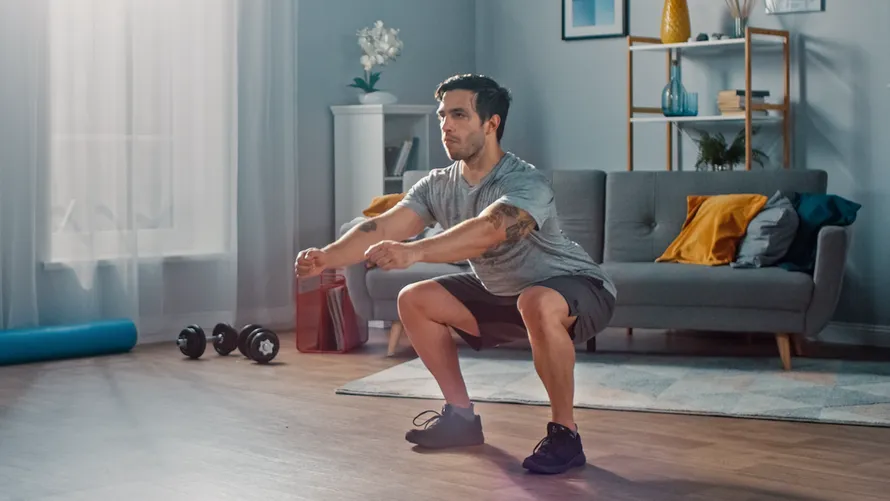April 26 | 2022

The COVID-19 pandemic saw people around the world searching for advice on how to practice martial arts in the comfort of their own home, far away from germs. While the world appears to be moving on from the pandemic, that doesn’t mean you shouldn’t still train at home.
The truth is, the best type of fitness is one you could hypothetically do in a prison cell. The beauty of the striking arts is that without any equipment or partner, you can still practice your skills. In this post, I will present a workout routine I developed for my students so they could train at home during the first lockdown here in the United Kingdom. But first, we need to talk about discipline.
When you start training at home, you’ll find that it’s easy to be motivated for the day, or maybe even for the week, but as time marches on and life gets in the way, your mind can stray. This is normal, and I too suffer from it even after a decade of training. So how do you avoid it?
Start a Martial Arts Training Habit
still use one. Find a time that you can reasonably do every day and set it.
Go about your day, but the second that alarm goes off, stop whatever you’re doing short of a legitimate emergency and spend the next 45 minutes training. Do this every day. Any day missed is a day that could break the habit and set you back for weeks. The more time you spend training, day in and day out, the easier it will be.
With that said, let’s begin. I will go over each portion of the program, then finish with the overall schedules. This routine features technique training six times a week, physical fitness four times a week, flexibility twice a week, and on a Sunday a rest-and-rehab session to aid recovery.
Solo Training Routine: Fitness
This section is based on building strength and conditioning geared specifically to martial arts. All work is done via bodyweight exercises, and the only piece of equipment necessary is a pull-up bar. If you aren’t able to hang a pull-up bar, you can substitute by doing resistance-band exercises.
Remember that eventually you need to reach a point where you can leave this basic routine behind and work with a professional coach in your area who can give you a routine tailor-made to you, but sticking to this plan for six months will have a great benefit on your overall fitness, especially for martial arts.
Warm-up, Part 1: Skipping Rope or Star Jumps
Beginner: 3 rounds of 1 minute (1-minute rest)
Intermediate: 3 rounds of 2 minutes (1-minute rest)
Advanced: 3 rounds of 3 minutes (1-minute rest)
Warm-up, Part 2: Dynamic Stretching
For the sake of ease, you will use five basic wushu kicks. It doesn’t matter if you don’t practice kung fu; these are the easiest ways to gain dynamic flexibility.
Front kick: 2 sets of 10 (alternating sides)
Side kick: 2 sets of 10 (alternating sides)
Outside crescent kick: 2 sets of 10 (alternating sides)
Inside crescent kick: 2 sets of 10 (alternating sides)
Flick kick: 2 sets of 10 (alternating sides)
Push-ups (Monday and Thursday)
Beginner: 3 sets of 10 reps (1-minute rest)
Intermediate: 3 sets of 15 reps (1-minute rest)
Advanced: 3 sets of 25 reps (1-minute rest)
Can’t do one push-up?
Attempt 3 sets of 15 kneeling push-ups. If you can’t manage that, drop the number of reps.
Pull-ups (Tuesday and Friday)
Beginner: 10 sets of 1 rep (1-minute rest)
Intermediate: 3 sets of 5 reps (1-minute rest)
Advanced: 3 sets of 10 reps (2-minute rest)
Can’t do one pull-up?
Try 10 sets of 1 negative pull-up, in which you jump up to the bar and slowly lower yourself. If you can do only one of these, that’s something to work with. Try to do one more the next day.
Squats (Monday and Thursday)
Beginner: 3 sets of 15 reps (1-minute rest)
Intermediate: 3 sets of 25 reps (1-minute rest)
Advanced: 4 sets of 25 reps (1-minute rest)
Can’t do one squat?
Find a table or other high surface. Put your hands on it, then lower yourself into the squat using the object to take some of the weight off. Try 3 sets of 20.
Solo Training Routine: Technique
This is a standard routine you can do every day, anywhere. It assumes you’re doing some form of kickboxing, be it muay Thai, sanda, etc. If you are in a martial art like karate or kung fu, you can still do all this alongside any forms training.
Round 1: Footwork (4 minutes)
Footwork is the basis of everything you do in any martial art or sport (except for pool and snooker, I guess). Do not neglect the first five minutes of this routine as it will help everything else fall into place.
Half-steps forward, backward, left and right (1 minute) — Lead with the correct foot, lengthen your stance, then return to your basic start without bringing your rear foot to follow it.
Full-steps forward, backward, left and right (1 minute) — Take full basic steps, ensuring your feet do not cross and your stance stays balanced.
Forward step followed by a pivot, rear step followed by a pivot (1 minute) — This is to practice evasive action.
Shadowboxing (footwork only) — Move freely around your space, ensuring that you are circling, pivoting, advancing and retreating with proper balance.
Rest for 2 minutes.
Round 2: Jab + Straight Kicks (3 minutes)
For one round, work exclusively on technique for your jabs and front kicks, be they snap kicks or teeps. These are the rangefinders and range maintainers, so they are essential for anyone practicing martial arts.
Ensure that your jab is performed without a flaring elbow. You can practice this by standing with your jabbing side to a wall.
Also ensure that the front kick is done without pulling you off-balance. Lean back slightly to bring your hips forward to keep the weight shift strong.
Round 3: All Punches + Straight Kicks (3 minutes)
You are now allowed to use all punches at your disposal. Make sure that as you throw a left hook, your weight comes to your right foot by the time the punch ends, and vice versa for the right hook.
When uppercutting, make sure your uppercut comes out like a rear straight with an upturned fist, having a moderate bend in the arm. This ensures that you’re training to strike an opponent who is a distance away from you. It’s easy to get into the habit of uppercutting straight up, where no opponent will ever be.
Round 4: Full Kickboxing (3 minutes)
You can now throw all kicks. Try to improve your kicking technique and balance by chaining multiple types of kicks off the same leg — for example, a left round kick followed by a left side kick. The better you are at doing multiple kicks off the same leg, the better dexterity and control you will have.
Round 5: All Legal Techniques (3 minutes)
Now it’s time for free-form shadowboxing. Use everything your martial art teaches. Just make sure to work on your defensive techniques, too.
Round 6: Punching Burnout (3 minutes)
Fill three minutes with as many punches and kicks as possible. Keep a record of how many full reps you achieve and try to beat your previous best each time you train.
Round 7: Kicking Burnout (3 minutes)
For the final round, spend 90 seconds throwing as many kicks as fast as you can. When you tire or run out of time, immediately switch to the other leg. Having proper bounce-kick technique from muay Thai can be helpful here.
Cool Down
Finally, cool down with light stretching of the lower back and legs. Start with your feet shoulder-width apart and gradually move them farther apart before reaching down on either side to stretch them completely.
Don’t attempt to go for extreme splits unless you already are able to do so or unless you have a specific routine for achieving the splits that is already planned out.
Finish by alternating between the horse stance, bow stance and crouching stance while practicing deep, controlled breathing.
Then after 5 minutes of gentle cooldown, you are done for the day.
The Schedule
Monday — fitness portion, technique portion
Tuesday — fitness portion, technique portion
Wednesday — warm-up (from the fitness portion), technique portion
Thursday — fitness portion, technique portion
Friday — fitness portion, technique portion
Saturday — warm-up (from the fitness portion), technique portion
Sunday — rest
